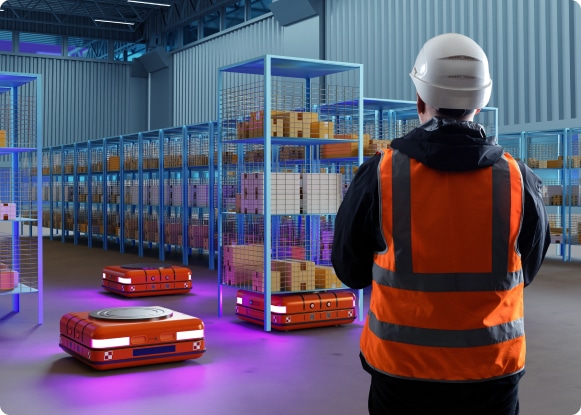AMR and AGV: an Effective Response to Logistics Challenges
Embrace the Future of Logistics with FM Logistic: Discover the advantages of AMRs and AGVs for efficient warehousing.
On August 7, 2023

Embrace the Future of Logistics with FM Logistic: Discover the advantages of AMRs and AGVs for efficient warehousing.
On August 7, 2023
In response to workforce shortages and a constant quest for efficiency, FM Logistic has implemented intelligent automation at its logistics sites to provide its customers with agile, high-performance solutions. This is illustrated by the use of AMRs and AGVs at various Group locations.
Although AMRs and AGVs have been around for some time, they have made significant progress with new technologies and can now move goods around warehouses with a high degree of autonomy and safety. They offer an expanding range of functionality, including load transport, handling, and stacking on pallet racks up to 10 meters high. Equipped with motion detectors, these intelligent robots can circulate freely around warehouses alongside logistics operators without compromising safety.
There are many benefits of mobility robotisation in warehouses, including higher throughput rates, reduced risk of picking errors and improved working conditions, as AMRs and AGVs often handle repetitive tasks. “These robots enable us to improve efficiency and generate economic gains, especially in pallet movement within the warehouse, which represents one of the highest costs,” emphasises Sébastien Lalesnel, Director of platform at Crépy-en-Valois. “They are also a solution to compensate for the intensifying recruitment challenges in our sector.”
Convinced that the future of logistics lies in automation, FM Logistic proactively offers its customers innovative and agile solutions tailored to their specific needs and project constraints at each stage of the logistics process.
The multi-activity warehouse at Fauverney (warehousing, handling, transport and co-packing) is equipped with several innovative solutions, including auto-dock, robotised storage, AGVs and AMRs, and automated packaging lines. These innovations are much appreciated by its customers in the food, health and industrial sectors. FM Logistic demonstrated its pioneering spirit with the early adoption of AGVs at its Neuville-aux-Bois site in 2016 and at Crépy-en-Valois (Crépy 2), where stacker AGVs were deployed to work alongside handlers in a shared environment. Since then, FM Logistic has continued to innovate, aiming to provide even greater value to its customers.
With a surface area of 118,000 m2, Crépy 2 is a logistics platform for mass retail customers, with a Reckitt, Colgate and Unilever co-packing workshop at its centre. Since March 2022, the site has been equipped with AGV stackers. “The AGVs pick up pallets from the co-packing area for Colgate and transport them to storage areas, stacking them up to 6 meters high,” explains Sébastien Lalesnel. “For Unilever’s storage areas, which are farther away from the co-packing workshop, the AGVs transfer the pallets to an intermediate area and forklift drivers then move them to the final storage zone.”
The implementation of AGVs has enabled FM Logistic to increase efficiency, reduce travel distances and allocate resources to other tasks – a crucial advantage given the current talent shortage. It is also a great showcase for its customers, who welcome this type of innovation. “One notable aspect of this project is the cohabitation of AGVs with traditional activities performed by forklift truck operators or order pickers,” emphasises Sébastien Lalesnel. “We supported our operators through this transition and explained the benefits of this project to them.”
FM Logistic is committed to a continuous improvement approach and continues to push the boundaries of innovation. In early 2024, AGVs will position Unilever pallets directly in the final storage zone on the ground without the need for an intermediate area. And in 2024/25, the AGVs will be capable of returning with a pallet of components to supply a co-packing production line. “This configuration will maximise the return on investment,” concludes Sébastien Lalesnel. “We need to optimise all AGV journeys, which is not yet the case, because at the moment they return empty once they have deposited the pallet.”
Fill in the form